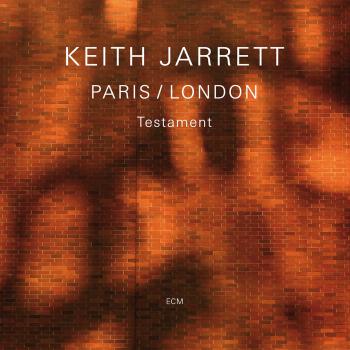
Fort Yawuh (Live) Keith Jarrett
Album info
Album-Release:
1973
HRA-Release:
30.04.2015
Label: Universal Music / impulse! Records
Genre: Jazz
Subgenre: Free Jazz
Artist: Keith Jarrett
Composer: Keith Jarrett [Non-Classical Composer]
Album including Album cover
I`m sorry!
Dear HIGHRESAUDIO Visitor,
due to territorial constraints and also different releases dates in each country you currently can`t purchase this album. We are updating our release dates twice a week. So, please feel free to check from time-to-time, if the album is available for your country.
We suggest, that you bookmark the album and use our Short List function.
Thank you for your understanding and patience.
Yours sincerely, HIGHRESAUDIO
- 1 (If The) Misfits (Wear It) 10:17
- 2 Fort Yawuh 11:14
- 3 De Drums 12:07
- 4 Still Life, Still Life 08:34
Info for Fort Yawuh (Live)
„On Fort Yawuh, Keith Jarrett is joined by Dewey Redman (tenor sax), Charlie Haden (bass), Paul Motian (drums), and Danny Johnson (percussion) to produce this set recorded live at the legendary Village Vanguard in New York City on February 24, 1973. About two minutes into 'Fort Yawuh,' Jarrett prepares the listener for a piano solo by announcing himself with quick and sharp keyboard jabs that evolve into spared and beautiful crescendos that before too long involve the soulful wails of Redman on the sax. The following song, 'De Drums,' is the one track that really swings on this album. Another long one, at 12 minutes in length, 'De Drums' is much more focused on a steady and consistent rhythm that is established immediately by a smooth five-note bassline accented by the piano and shakers. Although describable as smooth and cool, this song has a palpable energy perhaps due to the construction of the bassline whose pauses give an enjoyable sense of suspense. A little more than five minutes into this song there is a thematic shift that speeds up the tempo and makes this title swing even more while involving Redman's sax and Motian's drum kit. Half past the eight-minute mark the tempo settles back down to its original drawl, and the song finishes with a lazy bop that makes this the standout track on the album. Fans of Jarrett's avant-garde liberalism will find 'De Drums' to be the track most unlike the other four selections on this album. 'Still Life, Still Life' is more like a ballad in that it's very slow, but it still maintains the structural freedom featured in the 'Fort Yawuh,' '(If the) Mysfits (Wear It),' and 'Roads Traveled, Roads Veiled.' (Qa'id Jacobs, AMG)
'...The playing is both intimate and wild, with the leader's '60s-era, Ornette-inspired group injecting some funk, extra melody and extended vamps into all-Jarrett material.' (Down Beat)
Keith Jarrett, piano, soprano saxophone, tambourine
Dewey Redman, tenor saxophone, musette, clarinet
Charlie Haden, bass
Paul Motian, drums, percussion
Danny Johnson, percussion
Recorded live at the Village Vanguard, New York City on February 24, 1973
Recorded by Tony May
Produced by Ed Michel
Digitally remastered
Keith Jarrett
At the end of 2008, Keith Jarrett added two concerts to his schedule at short notice – one at Paris’s Salle Pleyel (November 26), one at London’s Royal Festival Hall (December 1) . The music on “Testament” is from these concerts. Their range is compendious, Jarrett’s improvisational imagination continually uncovering new forms, in a music stirred by powerful emotions. In his liner notes, the pianist is forthright about the personal circumstances promoting a need to lose himself in the work once more.
He also reminds the reader/listener that “it is not natural to sit at a piano, bring no material, clear your mind completely of musical ideas and play something that is of lasting value and brand new.” This, however, has been the history and substance of the solo concerts since Jarrett initiated them, almost forty years ago . Over time their connection to ‘jazz’ has often become tenuous, yet Jarrett’s solo concerts, with the foregrounding of melody and the continual building, and relinquishing, of structure, are also removed from “free improvisation” as a genre. Jarrett’s solo work is effectively its own idiom, and has been subject to periodic revisions by the pianist. “In the early part of this decade, I tried to bring the format back: starting from nothing and building a universe.”
Since the “Radiance” album and the “Tokyo Solo” DVD of 2002 Jarrett has been adjusting the flow of the work, more often working with shorter blocks of material. “I continued to find a wealth of music inside this open format, stopping whenever the music told me to.” This approach distinguished “The Carnegie Hall Concert” (2006), and it is most effectively deployed in “Testament” , where the strongly-contrasting elements of the sections of the Paris concert in particular have the logic of a spontaneously-composed suite. The nerves-bared London performance (the first UK solo show in 18 years) is different again: “The concert went on and, though the beginning was a dark, searching, multi-tonal melodic triumph, by the end it somehow became a throbbing, never-to-be-repeated pulsing rock band of a concert (unless it was a church service, in which case, Hallelujah!).”
In the end, the improviser does what must be done. As Keith Jarrett said, a long time ago, “If you’re a rock climber, once you’re halfway up the face of the cliff, you have to keep moving, you have to keep going somewhere. And that’s what I do, I find a way.”
These days, however, Jarrett is rationing the number of ascents: there have been less than thirty solo concerts in the last decade, making “Testament” a special event indeed. Two further solo performances are scheduled for 2009 – at the Palais des Beaux Arts in Brussels on October 9, and at Berlin’s Philharmonie on October 12.
This album contains no booklet.

























